For a mix of driving enjoyment, practicality, and affordability, nothing beats a hot hatch. The one that started it all, the Volkswagen GTI, continues to lead the pack, but many driving enthusiasts want a lower price, fewer long-term reliability concerns, or both. This might open the door wide for a Korean contender, but Hyundai's and Kia's chassis-tuning skills have lagged well behind the leaders.
Then the 2017 Hyundai Elantra Sport sedan suggested that the Koreans might be close to finally cracking the formula. In previous generations the Elantra GT, a hatchback developed primarily for the European market, has driven significantly better than the American-market-oriented Elantra sedan. If this continued with the fully redesigned 2018 Elantra GT, then Hyundai could finally have a compelling hot hatch. I've been eager to drive one to find out, and now I have.
The Honda Civic Si is aimed at the same target--almost. Sadly, Honda decided to offer the new Si only as a coupe or sedan. If you want a hatchback, you need to either take a slight step down to the Civic Sport or a huge step up to the Civic Type R. But I've been wanting to review the Si, and it's the Civic that Hyundai should be gunning for with both the Elantra Sport and the Elantra GT, so it's the one I drove for comparison.
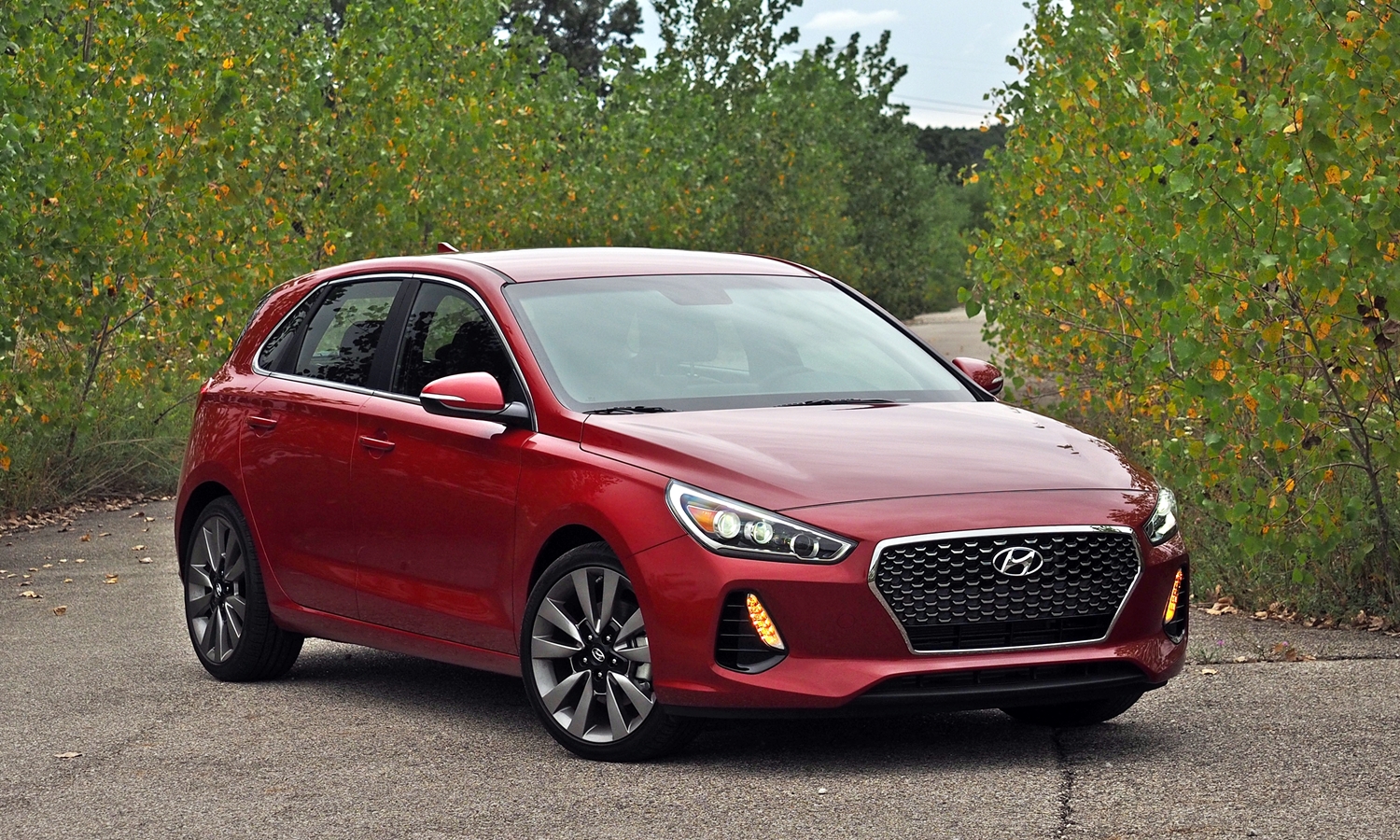
Not striking, but a handsome shape with a clear Audi influence. Sporty enough? more Elantra GT photos
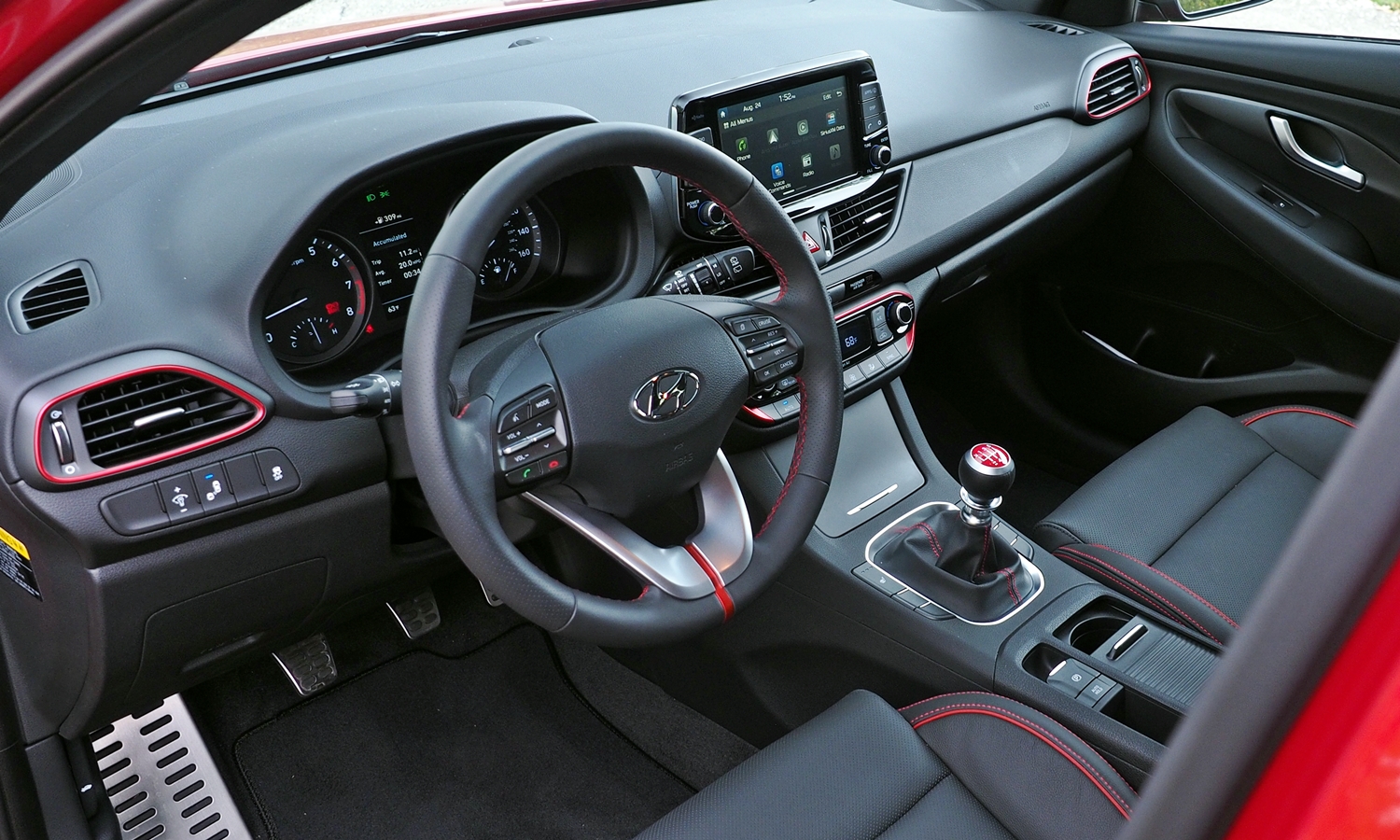
An unexpectedly upscale interior. Red details add just enough color.
| |
Compared to the Civic |
| Exterior styling |
 Better
Worse
Better
Worse
|
I'd really hoped that "handling" would occupy the top spot among the why-to-buys for the new Hyundai Elantra GT. But it's not in the list at all--I'll get to why it isn't below.
So why buy this car? When reviewing both the Elanta Sport and the previous Elantra GT I led with the most obvious reason to buy any Korean car: a long standard warranty. But is a long warranty all that compelling when the comparison car is a Honda or Mazda?
Fortunately for the new Elantra GT's prospects, it has some intrinsic strengths, most notably how it looks.
Go back two generations, and the 2009 Elantra Touring (as the European-market Hyundai i30 was initially badged for the American market) was, to put a positive spin on it, sensibly styled. Even when wrapped around an exceptionally functional interior sensible styling didn't sell. Hyundai attempted a correction by amping up the aesthetic drama with the 2013 Elantra GT. But that car's steeply raked windshield and upswept belt line sacrificed the Touring's outstanding outward sightlines without enticing potential buyers.
The 2018 Elantra GT strikes a happy medium between its predecessors in terms of swoopiness and surface drama, while appearing sportier and more sophisticated than either. Where the first Elantra GT expressed an Asian aesthetic, the new one could pass for a Volkswagen (its resemblance to the latest GTI likely isn't coincidental) or even an Audi (the previous employer of Hyundai's chief design officer). Oversized oddly shaped grilles have been the downfall of many recent car designs. Hyundai's latest grille, with an artful organic shape allegedly inspired by molten steel, actually works.
Meanwhile, Honda has taken the same eye-grabbing route Hyundai did with the 2013 Elantra GT (and then some) to escape the half-baked design disaster that was the 2012-2015 Civic, and has done so much more effectively. But does the eye like what has grabbed it? Mostly. At a glance the basic shape, swoopy and muscular, appears racier and more upscale than that of any previous Civic.
But Honda went too far, including too many design elements, some of them in dubious taste. Hopefully the large, obviously fake "vents" that dominate all four corners will not survive the upcoming mid-cycle refresh. If your tastes have evolved beyond the adolescent, the new Elantra GT's far cleaner design will seem more age-appropriate, if less exciting.
| Interior styling |
 Better
Worse
Better
Worse
|
Hyundai's designers did even better work inside the car, a pleasant surprise given how plain and even cheap the latest Elantra sedan's interior appears. Granted, the Elantra GT's interior (like its exterior) doesn't pack nearly as strong an aesthetic wallop as the Civic's (the latter could serve as a prop in a science fiction movie). But you won't find a more tasteful or more functional design in any competitor.
In all-black this Elantra GT's interior would verge on boring. Plentiful red highlights--trim rings, piping, stitching, the top of the shifter--save it from this fate. These might seem overly plentiful if they weren't so well executed in a shade more crimson than scarlet.
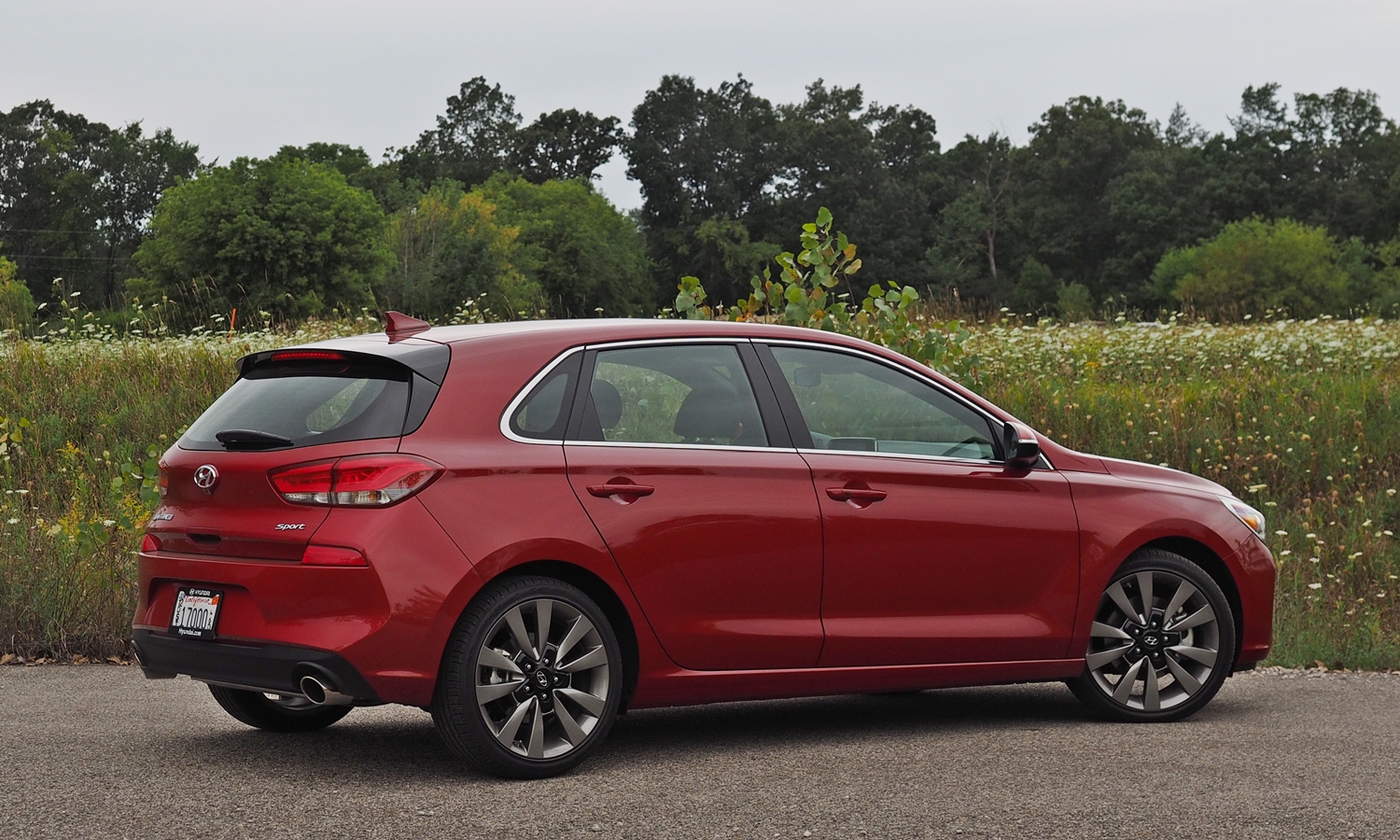
If you didn't already know, which brand would you think offered this car?
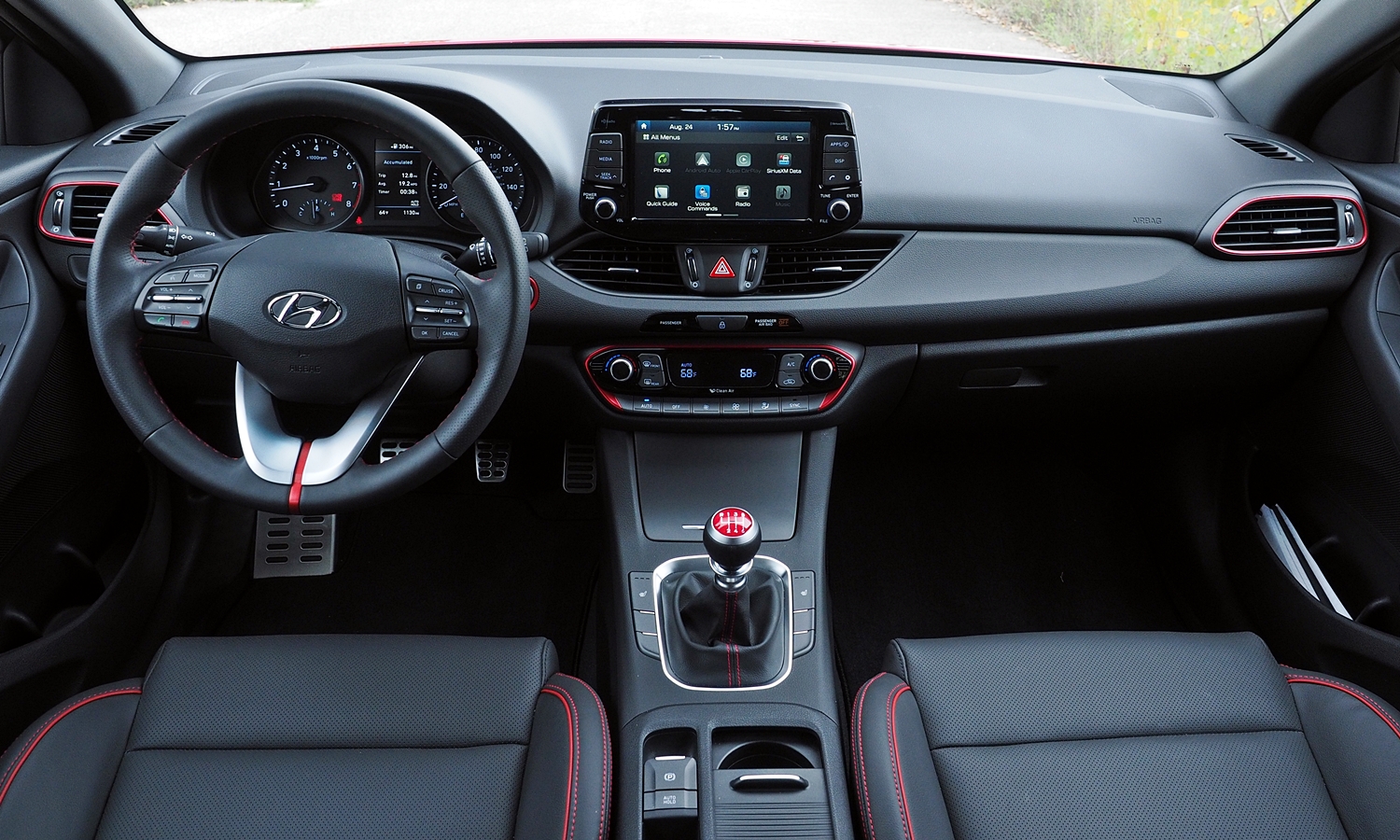
The placement of the infotainment display permits a lower instrument panel. Opportunity squandered.
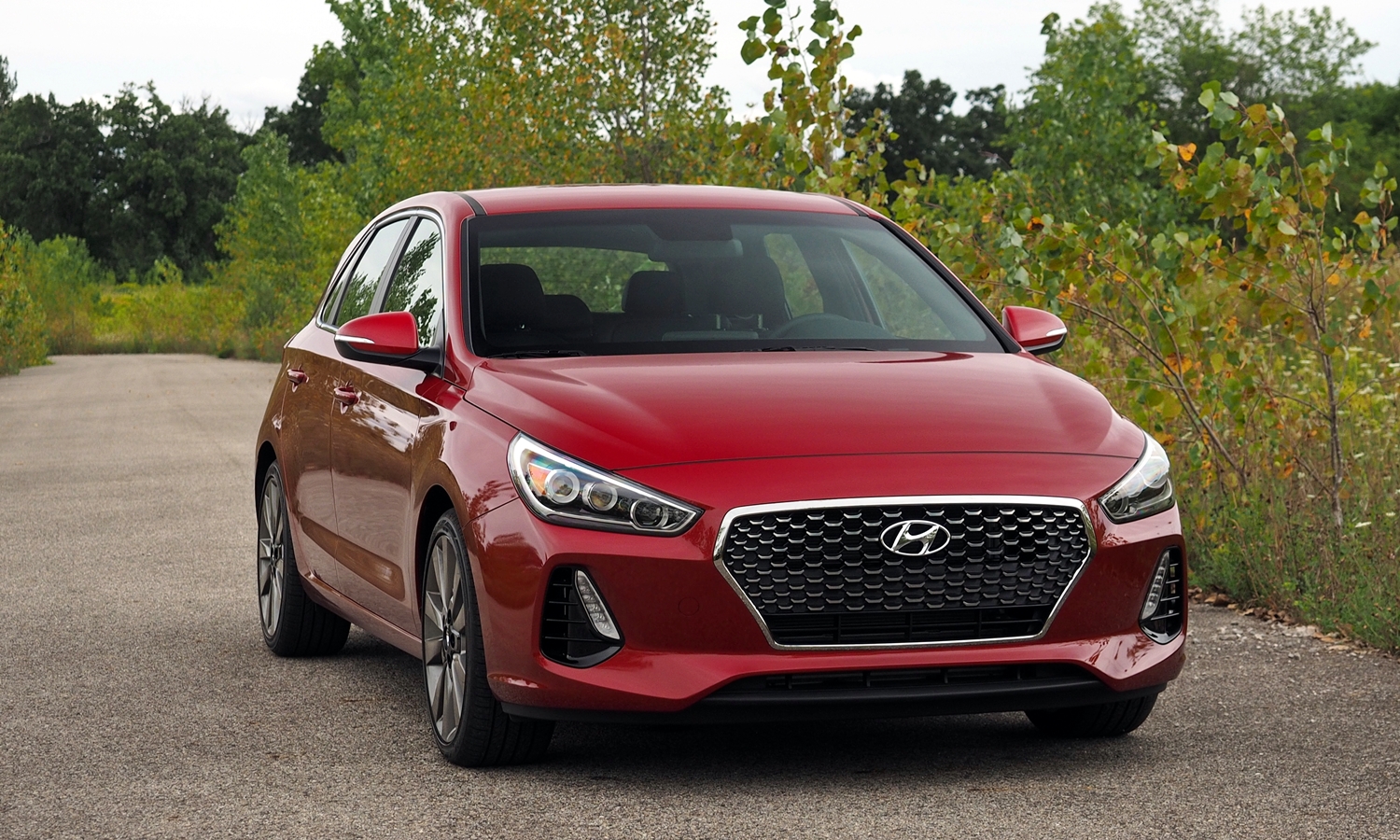
What do you think of Hyundai's latest grille design? I like it much better than its predecessors.

Rear seat on the tight side. Elantra Touring was much roomier.
| Driving position & visibility |
 Better
Worse
Better
Worse
|
Perhaps the best attribute of the reviewed car's grandpappy, the Hyundai Elantra Touring, was an outstanding driving position. Tall windows. Relatively shallow instrument panel. Thinnish pillars. The view from the driver seat inspired confidence.
With the first Elantra GT, Hyundai sacrificed this strength on the alter of futuristic styling. The dash was much deeper beneath a more steeply raked windshield. The rear windows were scrunched by a dramatically rising belt line.
The driving position of the new Elantra GT falls somewhere in between. Hyundai's interior designers positioned the infotainment display mostly above the leading edge of the instrument panel so that said instrument panel could be low. But the base of the windshield is about as high as the top of the infotainment display anyway. Consequently, I had to raise the driver seat to avoid feeling a little buried in the car. The view forward feels much more open in the Civic Si.
| Rear seat room & comfort |
 Better
Worse
Better
Worse
|
The front seats are comfortable and supportive in both cars, with Hyundai's likely agreeable for a wider range of body sizes and types.
And the rear seat?
Here we have another area where the Elantra Touring excelled, but neither Elantra GT has. The culprit this time isn't design, but a decision by those who make the big bucks at the corporate level. Hyundai offers Europeans the i30 (the same car with a different model name) in two lengths. These are marketed as a hatchback and as an estate or touring or tourer or kombi or whatever other label might help sell what Americans call station wagons. With the Elantra Touring, we got the latter, and consequently far more rear seat room and cargo carrying capacity than in any other compact hatchback. But we didn't buy the car. So with the first and second Elantra GT we've been getting the much less lengthy, more athletically proportioned hatchback.
As it stands (or rather, sits), the Elantra GT's rear seat shouldn't be condemned as useless unless you're a driver of above-average height with similarly sized passsengers. At 5-9, I fit behind a driver seat set for myself with perhaps three inches between my knees and the seat back and about a half-inch to spare between the top of my head and the headliner (in a two-pedal Elantra GT with the optional sunroof). But people even a couple inches taller than me will feel cramped. The rear seats in the GTI and Civic are roomier.
One plus in the Elantra GT's column: its rear seat passengers get air vents. The Civic's don't.
In terms of cargo space the Elantra GT is more competitive, but nothing special the way it was with the Elantra Touring.
| |
Compared to the Civic |
| Powertrain performance |
 Better
Worse
Better
Worse
|
If a new entrant to a performance-oriented category wants to be taken seriously, it better punch above its weight. The Hyundai Elantra GT does not. Its turbocharged 201-horsepower 1.6-liter is a parity engine. It performs in the same ballpark as the turbocharged 205-horsepower 1.5-liter engine in the Civic Si, but especially when paired with a manual transmission doesn't feel as responsive. Paired with a seven-speed DCT (dual clutch automated manual transmission) the 1.6T feels more eager, in no small part because you can select "sport mode." The mode selecter isn't offered with the manual transmission.
Both cars are a smidge quicker than the 184-horsepower 2.5-liter Mazda3--when the Mazda is fitted with a manual transmission. Fit Mazda's six-speed automatic--the best in the class--and it's as quick as the others despite less sporting pretensions.
Both the Elantra GT and Civic Si should have more power so they could pull well ahead of the Mazda3 and 180-horsepower Civic Sport and run with the VW GTI and Ford Focus ST.
Both easily could have had more power. Honda needn't go all the way up to the Civic Type R's 306-horsepower 2.0-liter engine. That's a bit much to expect at this price level. But how about the related 252-horspower 2.0T recently introduced in the Accord? Even if Honda had done this, Hyundai still could have made a splash by fitting the Elantra GT Sport with the 271-horsepower 2.0T recently introduced--in Europe--in the i30 N. Yes, they're already offering a far more competitive engine in this car--just not here.
Before moving on, I must backtrack. I've never been one to focus on power. Instead, I focus on the qualitative driving experience. None of the turbocharged engines, with their broad torque plateaus and ultra-linear power curves, has the zing of a highly tuned, high-winding naturally aspirated engine. I miss the peaky VTEC engines that made previous generations of the Civic Si such joys. Yes, the Mazda engine remains naturally aspirated but, designed to maximize fuel economy, it's not a revver. Sadly, the VTEC era has passed. And if an engine can't deliver thrills qualitatively, it better delivery them quantitatively. Hence my uncharacteristic request for more power.
Any engine depends on a good transmission to realize its potential. Both offered in the Elantra GT are just okay. The manual shifter moves smoothly from gate to gate. But it provides little feedback and none of the thoroughly engaging mechanical snick-snick you'll experience when rowing the Honda's lever.
The Elantra GT's DCT lacks the crisp, lightning quick responses of VW's. Though without the inherent advantage of dual clutches, Mazda's more conventional automatic also manages to be more responsive. That said, Hyundai's auto-box could be worse. At least it's not a CVT like that in the Civic Sport--which Honda wisely opted to not offer in the Si.
| Handling |
 Better
Worse
Better
Worse
|
As noted in the introduction, in previous generations Hyundai's European-market compacts have handled with more agility, precision, and stability than their American-market cousins. Unfortunately, with the latest generation the Elantra GT Sport hatchback doesn't handle as well as the Elantra Sport sedan even though, like the latter, it has an independent rear suspension that lesser Elantra GTs and Elantras do without.
Why not? The latest Elantra GT seems to have been tuned more for a refined ride-handling balance--which it delivers--than to feel agile or engaging. It's not that the Elantra GT got worse relative to its predecessor, but that the Elantra Sport got much better. And that neither feels as quick to respond or as capable as the Civic Si, much less more potent competitors.
Considerable blame is due the Elantra GT's steering. With the manual transmission, the single mode is far too light. In aggressive turns I had trouble sensing what the front tires where up to or how moving the wheel would alter the car's line. With the DCT, a sport mode can be selected, and this agreeably tightens up the steering. But the Civic's steering still feels quicker and more intuitive, making it much more fun of a curvy road.
On top of its superior steering, the Civic Si's chassis packs a few unfair advantages. A limited-slip front differential enables much more throttle when exiting curves. You needn't fear provoking wheelspin the way you do in the Hyundai. Adaptive dampers enable much tighter suspension tuning without killing ride quality. And brake-based torque vectoring counteracts understeer.
Since the Civic Sport also lacks these tricks, it's a more direct competitor for the Elantra GT Sport. But I don't want a Civic Sport competitor from Hyundai. I want a Civic Si competitor, at a minimum.
Not that the new Civic Si's handling is ideal. It feels like a larger, heavier, less agile car than previous Civic Si's. As with the change in engines something has been lost in the subjective driving experience even as objective capability has been gained.
| Ride smoothness |
 Better
Worse
Better
Worse
|
And ride quality? I could easily live with that of either the Hyundai Elantra GT or Honda Civic Si, even on the metro Detroit area's poor roads.
| Feature availability |
 Better
Worse
Better
Worse
|
The feature availability advantage can go to either the Hyundai or the Honda, depending on which features you want. Want a self-shifting transmission? Then it'll have to be the Hyundai unless you step down to the Civic Sport. Want leather seating surfaces or a power driver seat? Ditto. Want adaptive cruise control? Or collision warning systems? Ditto ditto.
Unless you also want a manual transmission, in which case you can't get the last two, a sunroof, or a premium audio system in the Elantra GT. A sunroof and premium audio system are standard in the Civic Si.
And, as mentioned in the handling section, if you want advanced chassis tech, the Civic Si is the way to go.
| Price or payments |
 Better
Worse
Better
Worse
|
The base Hyundai Elantra GT, with a 161-horsepower 2.0-liter engine, starts just over $20,000 before the inevitable discounts and incentives. Add $1,000 for a 6-speed automatic transmission.
Step up to the reviewed Elantra GT Sport, with a 201-horsepower turbocharged 1.6-liter engine and quite a bit of additional standard equipment (heated leather seats, LED headlights, proximity key, automatic climate control, blind spot warning), and the window sticker steps up to $24,135. Add $1,100 for the DCT. If you opt for the DCT, you can also add the Tech Package (panoramic sunroof, adaptive cruise control, forward collision warning, lane departure prevention, Infinity audio, nav, wireless charging, Homelink, ventilated front seats, power driver seat) for another $3,850, and a total of $29,085. Doesn't seem like quite the bargain Hyundais used to be, does it? Let's check...
Comparing the Elantra GT Sport manual's price to that of the Honda Civic Si is tricky because each has quite a few features you cannot get on the other. Without adjusting for these, the Hyundai lists for $840 less than the Honda. Adjust for the feature differences...and the result is virtually the same. The additional features on each--leather upholstery, LED headlights, and blind sport warning on the Elantra GT Sport, limited-slip differential, adaptive dampers, and sunroof on the Civic Si--nearly cancel out when using TrueDelta's default values. But one set of features could be worth much more than the other set to you.
As already mentioned, to get the Civic in hatchback form with a self-shifting transmission it's necessary to step down to the Civic Sport or (for leather and such) the Sport Touring. Load up both the latter and the Elantra GT Sport, and the Honda lists for $165 less. Too close considering that Hyundai's rep hasn't quite pulled even with Honda's? Well, the Elantra GT does include additional features (such as a larger sunroof, auto-dimming headlights, ventilated seats, power lumbar for the driver, and rear air vents) worth about $1,100, making for a feature-adjusted price advantage around $1,400. Enough? If not, discounts and incentives will likely be more generous on the Hyundai.
If you don't need or want a hatchback, the Elantra Sport sedan is significantly more fun to drive than the Elantra GT, and lists for $1,500 less. As such it undercuts the Honda Civic Si by a much more considerable amount. The catch? Its interior isn't as nice.
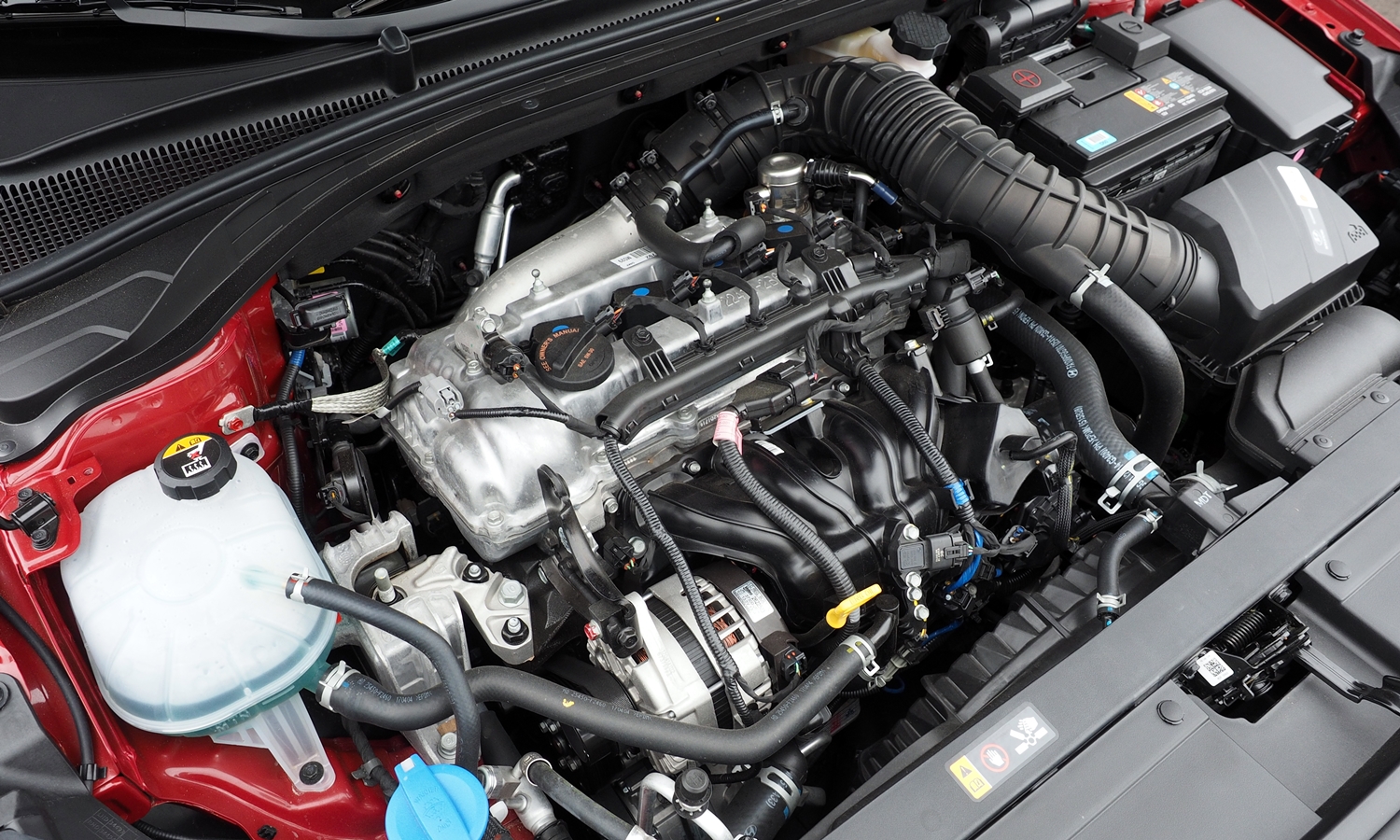
201-horsepower turbocharged 1.6-liter engine. Somewhat quick, but fuel economy marginal.

A useful amount of space with the seats folded, but no crossover substitute.











